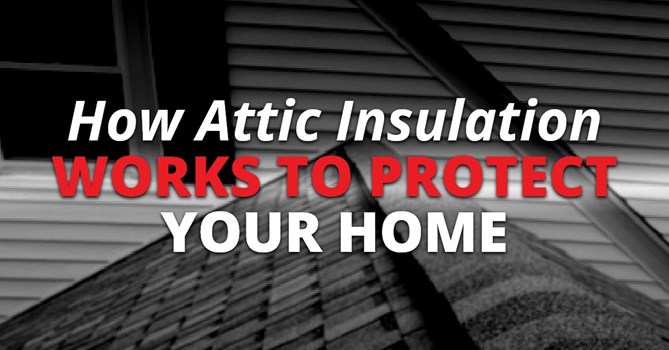How Attic Insulation Works To Protect Your Home

How attic insulation works is, for many homeowners, not how they think it works. A lot of science backs up the technology of modern attic insulation (or insulation anywhere in your home).
The Science Behind Snuggly
Your southeastern Massachusetts home should be comfortable for your entire family, from floor to ceiling, on every floor. Insulation helps accomplish that.
All insulation works by preventing the rapid flow of heat from hot regions to cold areas. It interrupts the flow of heat with air. Millions of tiny air pockets are trapped in the insulation, from fluffy, blown-in cellulose insulation to stiff foam board. Those air pockets slow heat transfer.
The air pockets slow down the movement of heat into or out of your home. Heat can only travel three ways:
- Conduction — physical contact between particles.
- Convection — movement within a fluid (air or liquid) with warmer particles rising and cooler particles falling.
- Radiation — movement of heat by electromagnetic waves.
Your home stays snug and warm in winter because of insulation in the attic and elsewhere. The insulation slows down the movement through hard and soft materials, air, and infrared radiation.
Gravity
Hot air rises for two reasons:
- Gravity pulls denser, colder air down.
- Hot air is less dense and rises to sit over cold air.
The expensively heated air inside your home rises to the ceiling, and if nothing pulls it back down to recirculate, it will rise right through your ceiling into your attic.
If nothing stops the warm air’s upward movement in the attic, it rises up and out of your house. And then your HVAC system kicks in and warms up incoming, colder air. And then your energy bills rise and rise and rise.
Insulation and your HVAC system’s air handler put a stop to the waste. Attic insulation is a crucial blanket over the top of the rising air. It slows the movement of heat, and it also reflects much of the heat back down into your living space. Having enough attic insulation is vital to driving down your home energy bills.
R-Value
A material’s R-value measures its thermal resistance (R for resistance). The material resists heat flow, as with fluffy, blown-in cellulose insulation and rigid foam board. The higher the R-value, the better the material resists heat moving within it.
The federal Energy Star insulation map tells us Massachusetts homes should have at least R49 to R60 attic insulation. If you already have some attic insulation between joists, topping it with R38 to R49 makes economic sense. (Above R60, you are wasting money on unnecessary insulation.)
Check-In
If you are comfortable crawling into your attic, you can inspect your own insulation to determine your needs. The rule is very simple:
- Can you see the joists? Then you need more insulation.
You may be tempted to run to the big-box home improvement store and buy a few rolls of paper-backed fiberglass insulation, called batts. But should you?
Working in a confined attic brings its own safety issues. Fiberglass is dangerous to your lungs. You also are unlikely to calculate your needs correctly.
A wiser move: contact your local insulation installer. Have your insulation service evaluate your attic and prepare a multi-pronged solution. Your installer can provide thorough attic insulation, including:
- Blown-in cellulose insulation.
- Rigid foam insulation where cellulose does not suit.
- Duct wrapping for ducts running through the attic.
- Radiant barrier insulation against the underside of the sheathing.
Why No Fiberglass?
Cellulose attic insulation is a quality product benefiting from years of technological improvements. Unlike most fiberglass products, cellulose will not settle quickly once blown into position. The material is treated with a borate solution to discourage insects and rodents. It has a Class-1 fire rating.
Cellulose insulation is manufactured from environmentally friendly newsprint, so you are helping keep Massachusetts clean when you opt for blown-in cellulose attic insulation.
Other materials helpful in preventing heat loss are rigid foam board, radiant barrier insulation (foam board coated with a metallic film), and spray foam duct insulation.
Savings
Attic insulation is a sure way to bring down your energy costs because you will retain more heat in winter and cool air in summer.
In addition to saving on your power and fuel bill, you will also save in other ways:
- Your HVAC system will operate for shorter periods and, less often, with sufficient attic insulation installed by experts.
- Your HVAC system will last longer and need fewer repairs because it will not work as hard as when your insulation was inadequate.
Couto Construction is ready to help you solve your energy issues in your Massachusetts home. Contact us today to learn what we can do to improve your attic insulation and ventilation. We also offer a complete range of roofing and exterior services.